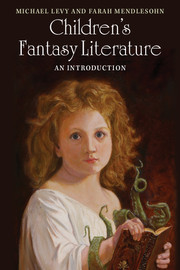Book contents
- Frontmatter
- Contents
- Acknowledgements
- Introduction
- 1 How fantasy became children's literature
- 2 Fairies, ghouls and goblins: the realms of Victorian and Edwardian fancy
- 3 The American search for an American childhood
- 4 British and Empire fantasy between the wars
- 5 The changing landscape of post-war fantasy
- 6 Folklore, fantasy and indigenous fantasy
- 7 Middle Earth, medievalism and mythopoeic fantasy
- 8 Harry Potter and children's fantasy since the 1990s
- 9 Romancing the teen
- Notes
- Further Reading
- Index
- References
5 - The changing landscape of post-war fantasy
Published online by Cambridge University Press: 05 April 2016
- Frontmatter
- Contents
- Acknowledgements
- Introduction
- 1 How fantasy became children's literature
- 2 Fairies, ghouls and goblins: the realms of Victorian and Edwardian fancy
- 3 The American search for an American childhood
- 4 British and Empire fantasy between the wars
- 5 The changing landscape of post-war fantasy
- 6 Folklore, fantasy and indigenous fantasy
- 7 Middle Earth, medievalism and mythopoeic fantasy
- 8 Harry Potter and children's fantasy since the 1990s
- 9 Romancing the teen
- Notes
- Further Reading
- Index
- References
Summary
In the years between 1950 and 1990, the landscape of children's fantasy in the UK and the Commonwealth changed in both literal and metaphorical ways. The physically constrained fantasies of the previous fifty years fell away as children explored other lands; the depiction of childhood changed; and children gained access to a far greater moral space within the fantastic. As children's fictional playgrounds expanded, so too did their sense of self. The awareness of being a child in the world rather than a child at home became an important element of post-war fantasy, and children's adventures became less localized, instead becoming rooted in an awareness of landscape, whether that was in the country, in the city, in the present or across time.
The period was so prolific, and so important to the development of children's fantasy, that we have chosen to split it into three sections. This chapter is concerned with the influence of the war, and the intervention of C. S. Lewis in the shape of children's fantasy. Chapter 6 will explore the growing influence of folklore in the development of urban fantasy. Of the two chapters, Chapter 5 is overwhelmingly concerned with the development of a new British tradition, while Chapter 6 explores the development of new urban folklores and fantasies across the Commonwealth. Chapter 7 returns to many of the authors considered in Chapters 5 and 6, exploring the ways in which they shifted the rhetoric and import of fantasy for children, the effect of this on the development of fantasy for teens, and the closing of the gap between fantasy for children and fantasy for adults.
The quest story
The thirty years after the war would prove to be a golden age of children's fantasy, fixing some of the dominant forms of the genre long before they became common in fantasy for adults. In this period, with so little fantasy published in the adult market (the influential American Ballantine Adult Fantasy line did not begin until 1969), and with the gradual disappearance of the family reading market which had been the main outlet for much adventure fiction, both fantastical and mimetic, children's fantasy drove innovation.
- Type
- Chapter
- Information
- Children's Fantasy LiteratureAn Introduction, pp. 101 - 116Publisher: Cambridge University PressPrint publication year: 2016

